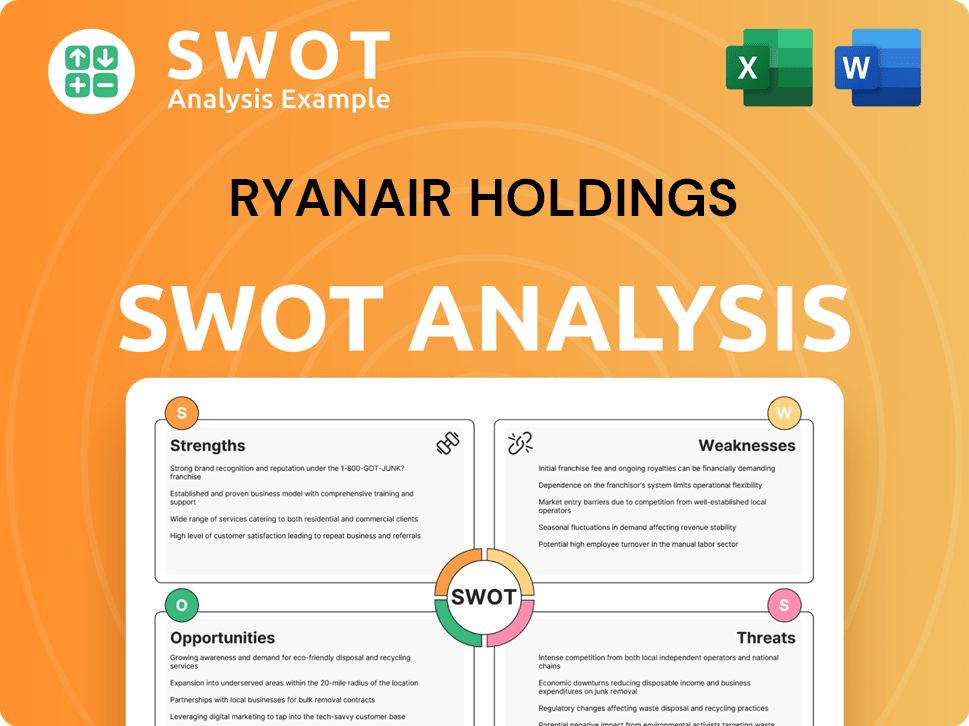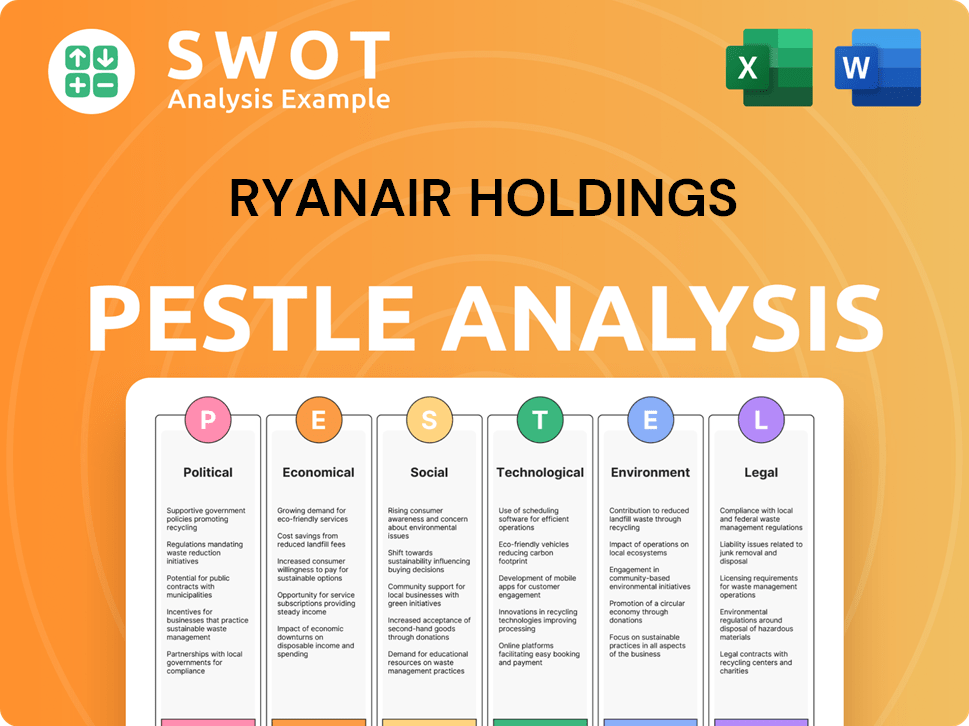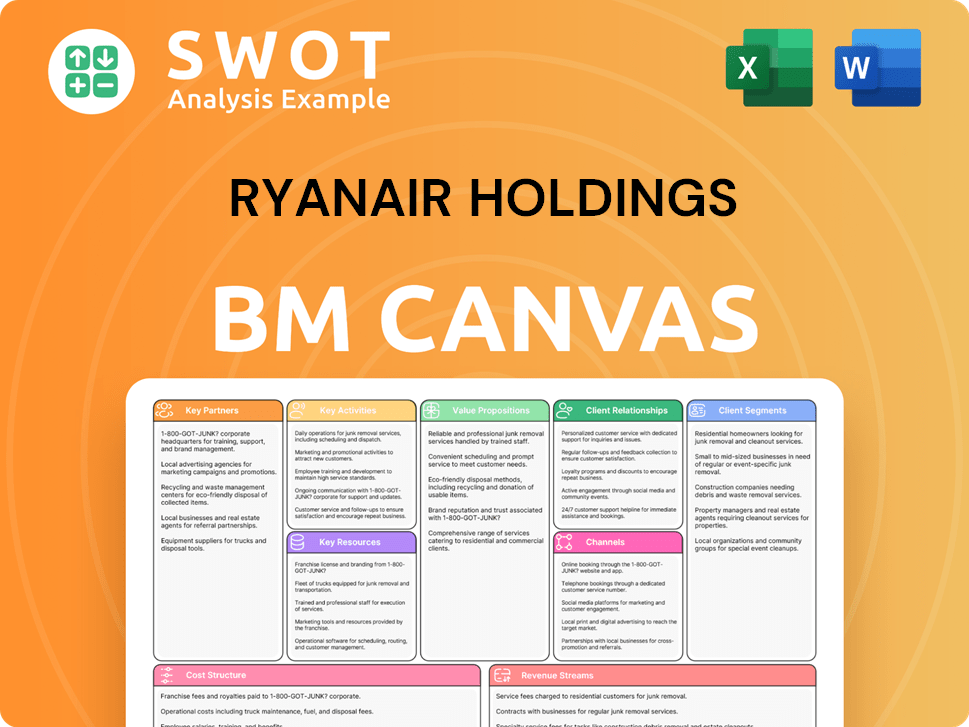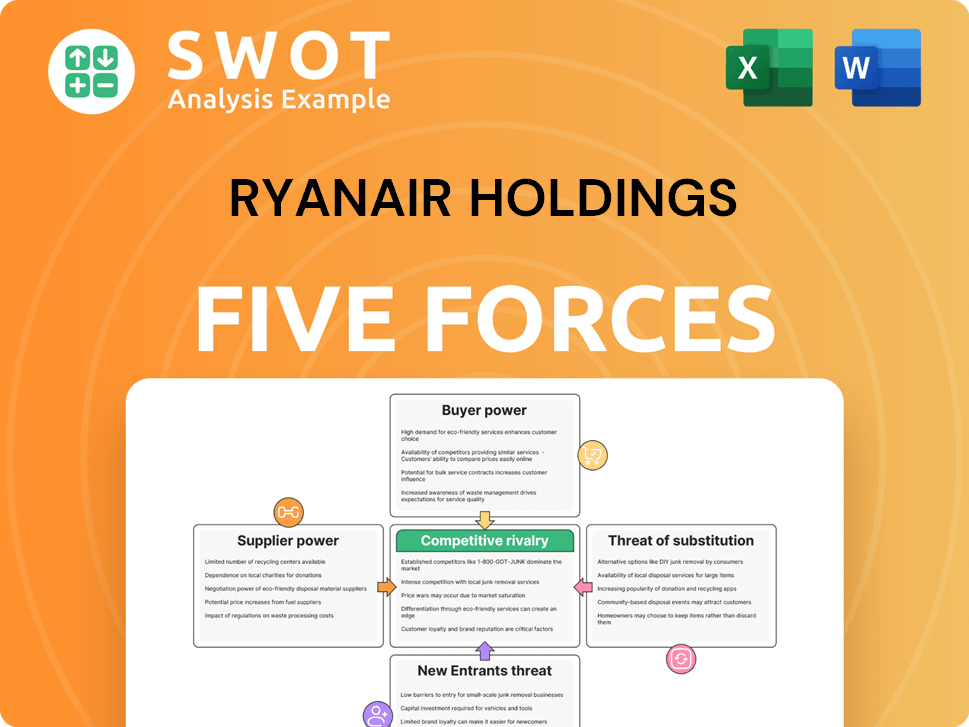Ryanair Holdings Bundle
Can Ryanair Maintain Its Flight Path to Success?
From a single aircraft to Europe's largest airline, Ryanair's journey is a masterclass in disruption. This analysis explores the Ryanair Holdings SWOT Analysis, revealing the core strategies that fueled its meteoric rise, fundamentally changing the aviation landscape. Understanding Ryanair's growth strategy is key to anticipating its future trajectory in a dynamic market.

Ryanair's success hinges on its unwavering commitment to its low-cost business model, which has allowed it to dominate the market. The airline's relentless focus on operational efficiency and cost reduction has been pivotal in its ability to offer competitive fares, attracting a vast customer base and enabling it to weather industry storms. This deep dive into Ryanair's Ryanair growth strategy and Ryanair future prospects provides a comprehensive Ryanair market analysis, offering insights into its Ryanair business model and low-cost airlines landscape.
How Is Ryanair Holdings Expanding Its Reach?
The core of the Ryanair growth strategy hinges on aggressive expansion across multiple fronts. This includes increasing its fleet size, opening new routes, and significantly boosting passenger numbers. Ryanair Holdings aims to solidify its position as a leading low-cost carrier in Europe by capitalizing on market opportunities and expanding its geographical footprint.
Ryanair's future prospects are closely tied to its ability to execute these expansion initiatives effectively. The company's strategic approach involves continuous route development, ancillary service enhancements, and leveraging its subsidiary airlines. These efforts are designed to drive revenue growth and maintain its competitive advantage in the low-cost airlines sector.
Ryanair's expansion plans are ambitious, targeting substantial growth in passenger numbers and fleet size. The company's strategic focus on cost efficiency and customer service improvements further supports its long-term goals.
Ryanair is significantly expanding its fleet with orders for new aircraft, particularly the Boeing 737 MAX, which enhances fuel efficiency and capacity. The airline projects passenger traffic to reach 183.5 million in fiscal year 2024. Ryanair aims for 300 million passengers annually by fiscal year 2034.
The airline is continuously adding new routes and establishing bases across Europe and North Africa. For Summer 2024, Ryanair announced its largest ever schedule for Cork, with 28 routes. Expansion from Dublin Airport includes 120 destinations for Summer 2024. This aggressive route development aims to increase market penetration.
Ryanair is enhancing its ancillary offerings, such as priority boarding and baggage fees, to boost per-passenger revenue. The company leverages its subsidiary airlines, like Lauda Europe and Malta Air, to optimize operations and cater to specific market niches. This strategy supports the overall group expansion.
Ryanair has expressed interest in expanding into the transatlantic market, potentially through partnerships. While specific timelines are not yet firm, exploring such opportunities is part of the company's long-term vision. This would diversify revenue streams beyond its traditional short-haul focus.
Ryanair's expansion strategy is multifaceted, involving fleet growth, route network optimization, and diversification of revenue streams. The company's focus remains on maintaining its competitive edge in the low-cost airlines market. For a deeper understanding of the competitive landscape, consider reading about the Competitors Landscape of Ryanair Holdings.
Ryanair's expansion plans are supported by significant investments in new aircraft and strategic route development. The airline's focus on ancillary revenue and operational efficiency further enhances its growth potential.
- Fleet expansion to 600 aircraft by fiscal year 2029.
- Continuous addition of new routes and bases across Europe and North Africa.
- Enhancement of ancillary services to maximize per-passenger revenue.
- Potential expansion into the transatlantic market.
Ryanair Holdings SWOT Analysis
- Complete SWOT Breakdown
- Fully Customizable
- Editable in Excel & Word
- Professional Formatting
- Investor-Ready Format

How Does Ryanair Holdings Invest in Innovation?
Ryanair's innovation and technology strategy is deeply intertwined with its low-cost business model. It prioritizes operational efficiencies, digital transformation, and enhancing the customer experience. This approach is crucial for maintaining its competitive edge in the low-cost airlines market.
The company's focus on technology is evident in its digital platforms, including its website and mobile app. These platforms are vital for direct sales, generating ancillary revenue, and streamlining customer interactions. These efforts are part of a broader strategy to improve customer engagement and drive repeat business.
A key aspect of Ryanair's technological strategy is its commitment to a modern and standardized fleet, primarily the Boeing 737. The introduction of the Boeing 737 MAX aircraft is a significant technological advancement. This aircraft offers increased seat capacity and improved fuel efficiency. This translates to substantial cost savings and reduced environmental impact.
Ryanair heavily invests in its digital platforms, including its website and mobile app. These platforms are crucial for direct sales and generating ancillary revenue. They also streamline customer interactions, contributing to a seamless booking experience.
The airline focuses on a modern and standardized fleet, mainly the Boeing 737. The Boeing 737 MAX aircraft is a significant technological leap. It offers increased seat capacity and improved fuel efficiency, leading to cost savings.
Ryanair uses advanced scheduling software and predictive maintenance. Data analytics are used to optimize routes, crew management, and pricing strategies. This contributes to operational efficiency and competitive fares.
Ryanair aims to reduce its CO2 emissions per passenger/kilometer. The goal is to achieve a 10% reduction by 2030. This commitment to fuel efficiency aligns with broader sustainability efforts.
Technology plays a crucial role in cost control. Advanced scheduling software, predictive maintenance, and data analytics are key. These tools help optimize various aspects of operations, contributing to the low-cost model.
Digital transformation efforts aim to make the booking process seamless. Personalized offers are also a focus. This leads to increased customer engagement and repeat business, enhancing the overall customer experience.
While not traditionally known for extensive R&D, Ryanair's innovation lies in operational optimization and leveraging technology for cost control. This includes advanced scheduling software, predictive maintenance, and data analytics. These tools optimize routes, crew management, and pricing, contributing to operational efficiency and the ability to offer competitive fares. Ryanair's consistent profitability in a competitive industry underscores the effectiveness of its technology-driven operational excellence. For more detailed insights, you can refer to a comprehensive analysis of Ryanair's business model and future prospects by reading the article about Ryanair Holdings.
Ryanair's technological advancements are geared towards enhancing efficiency and reducing costs. These advancements are crucial for the company's long-term growth strategy.
- Boeing 737 MAX: Offers increased seat capacity and improved fuel efficiency.
- Digital Platforms: Website and mobile app for direct sales and ancillary revenue.
- Data Analytics: Used for route optimization, crew management, and pricing strategies.
- Predictive Maintenance: Enhances operational efficiency and reduces downtime.
- Advanced Scheduling Software: Optimizes flight schedules and resource allocation.
Ryanair Holdings PESTLE Analysis
- Covers All 6 PESTLE Categories
- No Research Needed – Save Hours of Work
- Built by Experts, Trusted by Consultants
- Instant Download, Ready to Use
- 100% Editable, Fully Customizable

What Is Ryanair Holdings’s Growth Forecast?
The financial outlook for Ryanair Holdings is notably robust, driven by strong passenger growth and disciplined cost management. The company anticipates a profit after tax ranging between €1.85 billion and €1.95 billion for the fiscal year ending March 31, 2024. This positive projection reflects a significant improvement compared to previous periods, supported by an expected traffic growth to 183.5 million passengers in fiscal year 2024.
Ryanair's ambitious plans include increasing its annual traffic to 300 million passengers by fiscal year 2034. This growth strategy is built upon a foundation of high load factors and a strong balance sheet, allowing the company to maintain healthy profit margins even with its ultra-low fare strategy. The company's focus on operational efficiency and ancillary revenues further enhances its financial performance.
The company's financial strategy prioritizes organic growth and maintains a strong cash position, enabling it to self-fund its expansion initiatives without relying heavily on external capital. This conservative approach, combined with aggressive growth targets, positions Ryanair for continued financial strength and market leadership. For a deeper dive into the company's strategies, consider exploring the Marketing Strategy of Ryanair Holdings.
Ryanair aims to increase its annual traffic to 300 million passengers by fiscal year 2034. This ambitious target is a key indicator of Ryanair's future prospects. The company's financial performance is closely tied to its ability to achieve these passenger growth targets.
For the fiscal year ending March 31, 2024, Ryanair anticipates a profit after tax between €1.85 billion and €1.95 billion. This reflects a strong financial performance and is a key indicator of Ryanair's financial health. These projections are supported by expected traffic growth.
Ryanair's revenue streams include ancillary revenues, such as priority boarding and baggage fees, which significantly contribute to overall profitability. These additional revenue sources enhance revenue per passenger. The company's business model relies on maximizing revenue from various sources.
Capital expenditure plans are primarily directed towards fleet expansion, with significant investments in new Boeing 737 MAX aircraft. This investment in new aircraft supports the Ryanair growth strategy. Fleet expansion is crucial for achieving passenger growth targets.
Ryanair's financial strategy focuses on organic growth and maintaining a strong cash position.
- Strong Cash Position: Allows self-funding of expansion initiatives.
- Cost Management: Disciplined approach to maintain healthy profit margins.
- Ancillary Revenue: Enhances revenue per passenger.
- Fleet Expansion: Investment in new aircraft to support growth.
Ryanair Holdings Business Model Canvas
- Complete 9-Block Business Model Canvas
- Effortlessly Communicate Your Business Strategy
- Investor-Ready BMC Format
- 100% Editable and Customizable
- Clear and Structured Layout

What Risks Could Slow Ryanair Holdings’s Growth?
The growth strategy of Ryanair Holdings faces several potential risks and obstacles. These challenges include intense competition within the low-cost airline sector and the impact of regulatory changes. Furthermore, supply chain vulnerabilities and geopolitical instability pose significant threats to the company's operations and financial performance.
Intense market competition among low-cost airlines in Europe remains a constant challenge. Rivals continually adjust their pricing and service offerings to capture market share. Internal challenges, such as managing rapid growth while maintaining cost control and addressing employee relations, also present risks to the company.
Geopolitical instability and economic downturns can significantly affect travel demand and fuel prices, impacting Ryanair's profitability. The company's ability to navigate these risks is crucial for sustaining its growth trajectory and achieving its long-term goals. For a deeper dive into the company's financial workings, consider exploring the Revenue Streams & Business Model of Ryanair Holdings.
The low-cost airline market in Europe is highly competitive, with several airlines vying for market share. Ryanair faces competition from other low-cost carriers, such as easyJet and Wizz Air, which continuously adjust their strategies. These competitors often engage in price wars and offer similar services, putting pressure on Ryanair's pricing and profitability.
Regulatory changes, particularly those related to environmental policies and passenger rights, can impose additional costs or operational restrictions on Ryanair. Increased levies on aviation fuel or stricter emissions targets could impact Ryanair's cost structure. Changes in passenger rights regulations could also lead to increased compensation payments and operational complexities.
Supply chain vulnerabilities, especially concerning aircraft deliveries from manufacturers like Boeing, present a notable risk. Delays in receiving new aircraft can impact Ryanair's expansion plans and its ability to meet projected passenger growth targets. Delays in Boeing 737 MAX deliveries have impacted Ryanair's capacity growth in the past, affecting its ability to expand its route network and increase passenger capacity.
Geopolitical instability and economic downturns pose inherent risks, potentially impacting travel demand and fuel prices. Conflicts, economic recessions, or other global events can reduce passenger numbers and increase operational costs. Fluctuations in fuel prices, a major expense for airlines, can significantly affect profitability during economic downturns.
Internally, managing rapid growth while maintaining stringent cost control and operational efficiency is crucial. Employee relations, particularly with pilots and cabin crew, can also pose challenges, as evidenced by past industrial actions. Maintaining a balance between expansion and operational excellence is vital for long-term success.
Ryanair addresses these risks through diversification of its route network, robust risk management frameworks, and proactive engagement with regulators. The company's strong financial position provides a buffer against unforeseen shocks, allowing it to weather economic downturns more effectively than some competitors. Its experience in navigating crises, such as the COVID-19 pandemic, demonstrates its resilience and ability to adapt.
Ryanair's fleet expansion strategy is crucial for its growth, with a focus on acquiring new and fuel-efficient aircraft. As of March 2024, Ryanair has a total fleet of over 550 aircraft, with plans to add more in the coming years. The airline aims to increase its capacity and expand its route network, requiring significant investment in new aircraft and infrastructure.
Ryanair's financial performance is closely watched by investors and analysts. In its latest financial reports, the company has demonstrated a strong recovery from the pandemic, with increasing passenger numbers and revenue. For the fiscal year 2023, Ryanair reported a profit of over €1.43 billion, showcasing its financial resilience and operational efficiency. The company's ability to maintain cost control and adapt to market changes is key to its financial success.
Sustainability initiatives are becoming increasingly important for airlines, and Ryanair is investing in various projects to reduce its environmental impact. The company is focusing on fuel efficiency, reducing emissions, and exploring sustainable aviation fuels (SAF). Ryanair's commitment to sustainability is crucial for its long-term goals and its ability to meet evolving environmental regulations and consumer expectations. They are committed to achieving net-zero carbon emissions by 2050.
Ryanair forecasts continued passenger growth in the coming years, driven by its expansion plans and competitive pricing. The airline aims to increase its passenger numbers significantly, with projections indicating a substantial increase in the next five years. This growth is supported by the airline's fleet expansion strategy and its focus on expanding its route network. Ryanair is aiming to carry over 225 million passengers by 2026.
Ryanair Holdings Porter's Five Forces Analysis
- Covers All 5 Competitive Forces in Detail
- Structured for Consultants, Students, and Founders
- 100% Editable in Microsoft Word & Excel
- Instant Digital Download – Use Immediately
- Compatible with Mac & PC – Fully Unlocked

Related Blogs
- What are Mission Vision & Core Values of Ryanair Holdings Company?
- What is Competitive Landscape of Ryanair Holdings Company?
- How Does Ryanair Holdings Company Work?
- What is Sales and Marketing Strategy of Ryanair Holdings Company?
- What is Brief History of Ryanair Holdings Company?
- Who Owns Ryanair Holdings Company?
- What is Customer Demographics and Target Market of Ryanair Holdings Company?
Disclaimer
All information, articles, and product details provided on this website are for general informational and educational purposes only. We do not claim any ownership over, nor do we intend to infringe upon, any trademarks, copyrights, logos, brand names, or other intellectual property mentioned or depicted on this site. Such intellectual property remains the property of its respective owners, and any references here are made solely for identification or informational purposes, without implying any affiliation, endorsement, or partnership.
We make no representations or warranties, express or implied, regarding the accuracy, completeness, or suitability of any content or products presented. Nothing on this website should be construed as legal, tax, investment, financial, medical, or other professional advice. In addition, no part of this site—including articles or product references—constitutes a solicitation, recommendation, endorsement, advertisement, or offer to buy or sell any securities, franchises, or other financial instruments, particularly in jurisdictions where such activity would be unlawful.
All content is of a general nature and may not address the specific circumstances of any individual or entity. It is not a substitute for professional advice or services. Any actions you take based on the information provided here are strictly at your own risk. You accept full responsibility for any decisions or outcomes arising from your use of this website and agree to release us from any liability in connection with your use of, or reliance upon, the content or products found herein.